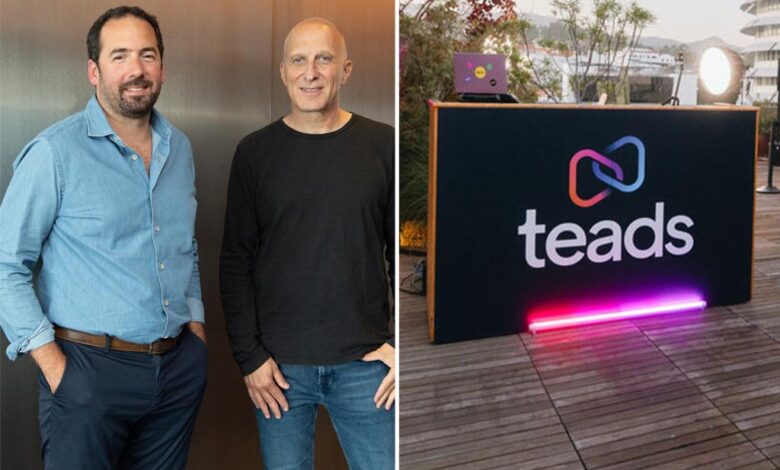Teads returns to Cannes Lions post Outbrain merger

Teads is making a comeback at Cannes Lions following the merger with Outbrain, emphasizing how the combined company can assist brands in utilizing artificial intelligence, targeted advertising, and data-driven strategies to grow their businesses and reach their target audience.
CEO David Kostman and Chief Business Officer of the Americas Jeremy Arditi discuss with The Post about the post-merger life, the company’s collaborations with news publishers to reclaim advertising revenue, and the utilization of AI.
Q: What is Teads’ mission and how do you support clients in maximizing their advertising strategies?
David Kostman: Teads aims to create a platform that delivers optimal results on a large scale on the open internet, ensuring success for advertisers across various campaign objectives. We strive to be the go-to partner for brands and agencies, helping them effectively connect with their audience throughout the consumer journey by balancing branding and performance marketing strategies to drive real business outcomes.
Jeremy Arditi: Historically, brands have relied on fragmented solutions for advertising on the open internet. Teads aims to provide a unified platform for advertisers to reach a broad audience and achieve stronger business results with a cohesive full-funnel approach. Our goal is to help marketers strike the right balance between brand awareness and performance gains and seamlessly execute their strategies.
Q: How has Cannes Lions evolved for your company and what are you most looking forward to this week?
DK: Since the merger of Outbrain and Teads just four months ago, we are excited to showcase the Teads brand and its strategic direction at Cannes Lions this year. It provides us with a great opportunity to engage with our partners, delve into industry discussions, and highlight the role of Teads in shaping the future of advertising.
JA: In the current landscape, where brands are increasingly focused on measurable outcomes amidst economic uncertainty, we anticipate Cannes Lions to focus on advertising efficiency, results, and the impact of AI. The new vision and mission of Teads align well with these themes, and we aim to demonstrate how we can support our partners in navigating these critical issues.
Q: Outbrain recently acquired Teads. How has that enhanced your business?
DK: The merger of Outbrain and Teads has created one of the largest advertising platforms on the open internet, with over $1.6 billion in gross advertising spend. This union brings together expertise in performance advertising, predictive modeling, omnichannel branding, and video, enabling brands to optimize their advertising strategies comprehensively.
JA: Our tagline “Elevated Outcomes” embodies the vision of the new Teads, emphasizing our focus on driving tangible business results while exceeding advertiser expectations in delivering creative experiences across various platforms. The market response to this value proposition has been positive, reflecting the interest in our merger and the value we offer.
Q: With economic uncertainty and cautious consumer spending, have you observed any impact on advertising budgets?
DK: Advertisers are increasingly prioritizing real business outcomes in the current economic climate. They seek clear insights into the impact of their marketing efforts on sales ROI, requiring platforms that can provide actionable solutions and measurable results for every investment type.
true business outcomes in the uncertain economy. Teads
Q: Can you share examples of your successful partnerships?
JA: Teads has established over 50 Joint Business Partnerships with Fortune 500 brands globally, demonstrating our consultative approach and understanding of brand objectives and audience preferences. With the new Teads, we aim to expand our services to provide seamless branding and performance strategies across various platforms, driving stronger business outcomes for our partners.
Our partnerships with companies like Stagwell and Prohaska are focused on redirecting awareness and investments back to premium news content, showcasing the effectiveness of advertising on quality news platforms.
Q: Brands have been cautious about advertising with news publishers. How do publishers address this issue, and what strategies have proven successful?
DK: The hesitancy around advertising on news publishers stems from perception rather than performance issues. Brands often avoid trusted news platforms due to concerns, while inadvertently supporting misinformation on social media. Publishers can combat this by emphasizing data-backed insights that demonstrate the effectiveness of ads on quality news content. By leveraging technology to ensure brand safety, publishers can rebuild trust with advertisers.
Teads is collaborating with partners like Stagwell and Prohaska to promote premium news content and encourage brands to invest in reputable news publishers.
When brands realize that these environments are not only safe but effective, they begin to see the value. It’s not about convincing them to support journalism on principle alone – it’s about demonstrating that it actually works.
Q: How will AI accelerate the open internet’s ability to become a complement to walled-garden advertising strategies?
DK: Walled gardens have been successful in delivering results due to their algorithmic approach, which is directly linked to deterministic user behavior and interests, optimized to achieve advertiser goals across a wide range of media environments. However, their access is limited to specific user moments and mindsets – the open internet offers a broader spectrum of moments to create awareness, influence purchasing decisions, and drive results. Consequently, it possesses one of the most diverse ranges of engagement, attention, and interest data signals to power AI models.
Effectively leveraging these signals can help us tap into a much larger opportunity in terms of connecting consumer experiences across screens to drive results. AI will enable us to bridge crucial gaps in understanding how consumers progress through a brand’s marketing funnel. While in the past, deterministic insights into the user’s profile were crucial for this, AI is now challenging us to reconsider the essential factors needed to deliver a compelling, relevant consumer experience that aligns brand offerings with consumer moments.
Q: What is the future of platforms and demand-side platforms as brands navigate and harness AI transformation?
JA: AI is poised to transform the future of platforms and DSPs [demand-side platforms], particularly in how brands develop and expand campaigns. From a creative standpoint, it facilitates the rapid creation and testing of personalized, high-quality assets across screens – a capability that was previously limited to larger advertisers. Simultaneously, AI is reducing barriers to entry in CTV, making premium video more accessible to small and medium businesses by cutting costs and simplifying production. As AI continues to advance, the future of advertising will not only be determined by budget size but by how intelligently technology is utilized.





